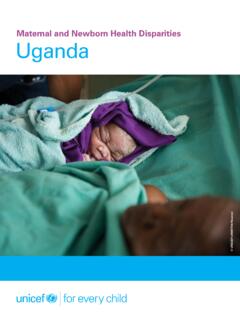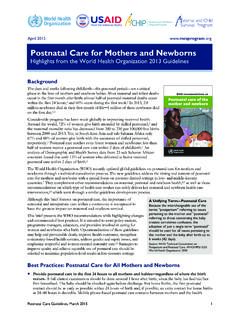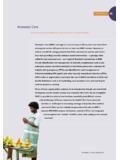Transcription of Clinical practice pocket guide - WHO
1 Early EssEntial newborn care Clinical practice pocket guideWHO Library Cataloguing-in-Publication DataEarly essential newborn care : Clinical practice pocket guide1. Infant care methods. 2. Infant, newborn . 3. practice guidelines as topic. I. World Health Organization. Regional Office for the Western 978 92 9061 685 6 (NLM Classification: WS 113) World Health Organization 2014 All rights reserved. Publications of the World Health Organization are available on the WHO website ( ) or can be purchased from WHO Press, World Health Organization, 20 avenue Appia, 1211 Geneva 27, Switzerland (tel. +41 22 791 3264; fax: +41 22 791 4857; e-mail: Requests for permission to reproduce or translate WHO publications whether for sale or for non-commercial distribution should be addressed to WHO Press through the WHO website ( ).)
2 For WHO Western Pacific Regional Publications, request for permission to reproduce should be addressed to Publications Office, World Health Organization, Regional Office for the Western Pacific, Box 2932, 1000, Manila, Philippines, fax: +632 521 1036, e-mail: designations employed and the presentation of the material in this publication do not imply the expression of any opinion whatsoever on the part of the World Health Organization concerning the legal status of any country, territory, city or area or of its authorities, or concerning the delimitation of its frontiers or boundaries. Dotted lines on maps represent approximate border lines for which there may not yet be full mention of specific companies or of certain manufacturers products does not imply that they are endorsed or recommended by the World Health Organization in preference to others of a similar nature that are not mentioned.
3 Errors and omissions excepted, the names of proprietary products are distinguished by initial capital reasonable precautions have been taken by the World Health Organization to verify the information contained in this publication. However, the published material is being distributed without warranty of any kind, either expressed or implied. The responsibility for the interpretation and use of the material lies with the reader. In no event shall the World Health Organization be liable for damages arising from its use. Early EssEntial newborn carEClinical practice pocket guidecontEntsForEworDWomen are especially vulnerable during labour, birth and immediately after birth. A newborn infant dies every two minutes in the Western Pacific Region, accounting for more than half of all under-five child deaths.
4 Many of these deaths are preventable. In a push to meet the Millennium Development Goals (MDGs) 4 and 5 relating to women and children s health, United Nations Secretary-General Ban Ki Moon championed the Global Strategy on Women s and Children s Health (2010). In his initiative, the UN Secretary-General called on governments, United Nations agencies and other stakeholders to take actions towards achieving these targets in MDGs 4 and , Every newborn : An Action Plan to End Preventable Deaths (2014) was developed by the World Health Organization (WHO), the United Nations Children s Fund (UNICEF) and other partners. At the same time, the Action Plan for Healthy newborn Infants in the Western Pacific Region (2014 2020) was developed by the WHO Regional Office for the Western Pacific and UNICEF s East Asia Pacific Regional Office.
5 Both plans highlight key actions that Member States and development partners can engage to increase maternal and newborn survival rates, particularly by enhancing the quality of care . Supporting Member States to update Clinical protocols, the Regional Office has now developed the Early Essential newborn care : Clinical practice pocket guide . This practical, hands-on reference volume provides health workers with WHO-recommended steps to care for mothers during labour and delivery and for newborn infants after birth. Within these pages, health workers will find effective, low-cost recommendations that can be easily implemented even at the community level. For example, the First Embrace is a simple, yet vital, sequence of steps in immediate newborn care focusing on maximizing newborn contact with the mother that have been proven to dramatically improve outcomes.
6 Special attention is also paid to common practices that are harmful and must be stopped. With our collective will and sustained efforts along with practical guidance we can improve the lives of and save 50 000 young lives every Young-soo, MD, DirectorForeword ..iiiAcknowledgements ..ivAcronyms ..vRationale, purpose and intended users ..viDevelopment of the guide ..viiHow to use the guide ..viii1. Preparing for a birth Algorithm 1 ..22. Immediate newborn care : the first 90 minutes Algorithm 2 ..123. newborn care (from 90 minutes to 6 hours) ..244. care prior to discharge (but after the first 90 minutes) ..325. care from discharge to 6 weeks ..426. Additional care .
7 50 A. newborn resuscitation Algorithm 3 ..50 B. care for a small baby (or twin) Algorithm 4 ..58 C. Dealing with feeding problems ..657. Setting up the environment for good neonatal care ..72 A. Preparing for shifts ..72 B. After every C. Standard precautions ..738. Equipment and supplies maintenance checklist ..849. Index ..9010. Bibliography ..94 `iiiacknowlEDgEmEntsWHO expresses its gratitude to the following experts, who participated in the technical review, for their comments and recommendations for updating the Early Essential newborn care : Clinical practice pocket guide : Professor Trevor Duke, Director/Head, Centre for International Child Health, WHO Collaborating Centre for Research and Training in Child and Neonatal Health, Melbourne, Australia; Dr Uwe Ewald, Professor/Director, Department of Neonatology, Department of Women s and Children s Health, Uppsala University Hospital, Uppsala, Sweden.
8 Dr Feng Qi, Director, Division of Intensive care Medicine, Department of Pediatrics, Peking University First Hospital, Beijing, People s Republic of China; Dr Joan Skinner, Senior Lecturer, Graduate School of Nursing, Midwifery and Health, Victoria University of Wellington, Wellington, New Zealand; Dr John Murray, International Health Consultant, United States of America; and Dr Nabila Zaka, Maternal and Child Health Specialist, Young Child Survival and Development Section, UNICEF East Asia Pacific Regional Office, Bangkok, gratitude is owed to Kalusugan ng Mag-Ina (KMI), Philippines and its President, Dr Maria Asuncion Silvestre who incorporated the changes and prepared the first draft of the Clinical practice pocket guide .
9 AcronymsART antiretroviral therapyBCG bacille Calmette-Gu rin (vaccine)BP blood pressureHIV human immunodeficiency virusHLD high-level disinfectionHR heart rateIM intramuscularIU International UnitIV intravenousKMC kangaroo mother careLBW low-birth-weightPR pulse ratepPROM preterm prelabour rupture of membranes RPR rapid plasma reaginRR respiratory rateVLBW very low-birth-weightUNICEF United Nations Children s FundVDRL Venereal Research Disease LaboratoryWHO World Health Organization `v `iv `ivrationalE, PurPosE anD intEnDED usErsApproximately every two minutes, a baby dies in the WHO Western Pacific Region. The majority of newborn deaths occur within the first few days, mostly from preventable causes.
10 The high mortality and morbidity rates among newborns are related to inappropriate hospital and community practices that currently occur throughout the Region. Furthermore, newborn care has fallen into a gap between maternal care and child guide aims to provide health professionals with a user-friendly, evidence-based protocol to essential newborn care focusing on the first hours and days of target users are skilled birth attendants including midwives, nurses and doctors, as well as others involved in caring for newborns. This pocket book provides a step-by-step guide to a core package of essential newborn care interventions that can be administered in all health- care settings.















